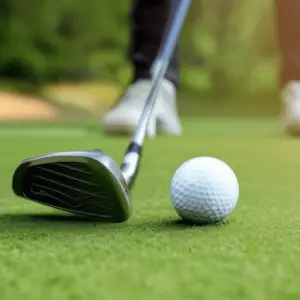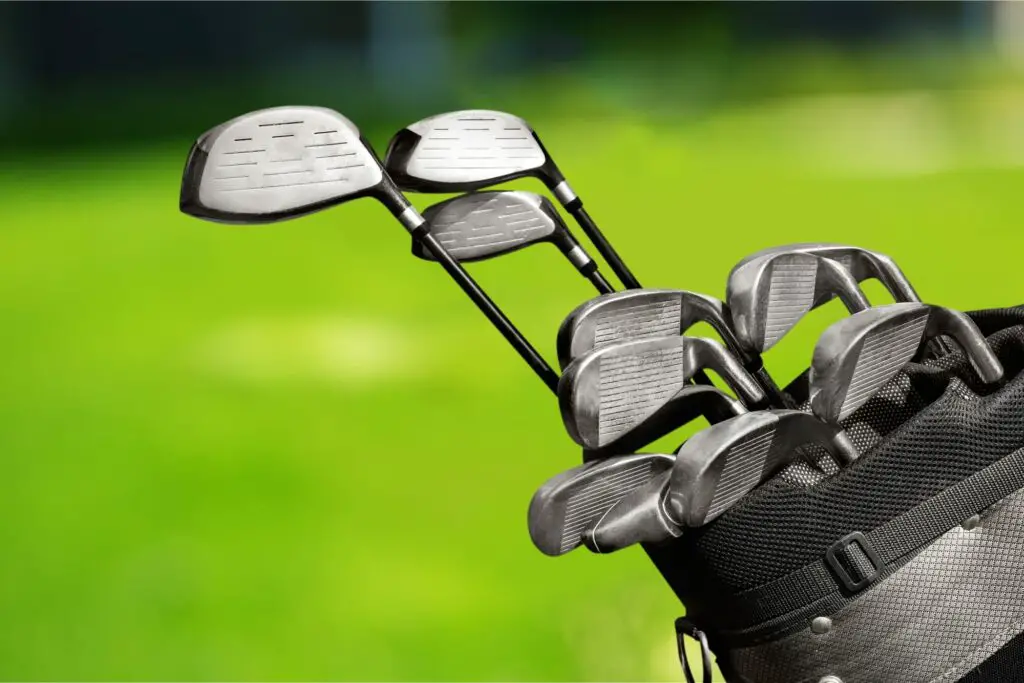Last Updated on May 31, 2023
Golf clubs made of various materials can make a big difference in your game. From titanium to steel, graphite to wood, ceramic and composite – the options are endless. So, which material is the best fit for you? In this blog post, we’ll delve into the advantages of golf clubs made from a variety of materials to help you determine which one is ideal for your game. So grab your driver, and let’s get started on our journey to understanding how each material affects performance on the course.
Table of Contents:
- The Benefits of Titanium Golf Clubs
- Steel vs Graphite: Which Is Better?
- Wooden Golf Clubs: A Classic Choice
- Ceramic Golf Clubs: An Innovative Option
- Composite Golf Clubs: The Best of Both Worlds
- Conclusion
The Benefits of Titanium Golf Clubs
Titanium golf clubs are the go-to choice for many professional and amateur golfers. Titanium is a lightweight metal that offers several advantages over other materials, such as steel or graphite. Its durability, flexibility, and strength make it an ideal material for constructing golf clubs.
When it comes to weight, titanium reigns supreme. It’s much lighter than steel but just as strong – meaning you can create larger club heads without sacrificing swing speed or distance control. This makes titanium particularly well suited to longer irons and woods, which require more mass in the head to generate power on impact with the ball. As a result of its lightness, titanium also helps reduce fatigue during long rounds of play by reducing strain on your arms and shoulders when swinging your clubs repeatedly throughout a round of 18 holes.
In terms of feel, titanium has excellent shock absorption qualities, which help dampen vibrations caused by off-centre strikes resulting in less harsh feedback through the shaft when compared to other materials like steel or graphite. On top of this, due to its superior strength properties, it can be formed into thinner faces while still maintaining structural integrity – allowing manufacturers to produce large sweet spots on their drivers with minimal face thicknesses improving forgiveness even further.
The last advantage that sets titanium apart from its counterparts is its ability to retain loft better than any other material used in club construction today, meaning you won’t have to worry about losing yards due to wear and tear over time as some players do with their old faithful wooden clubs. In addition, unlike wood which needs frequent maintenance (such as sanding down) every few years, titanium requires no such upkeep making them great value for money if you plan on playing regularly over extended periods of time.
Overall, there are plenty of reasons why so many serious players choose titanium for their equipment. Whether they want maximum performance out on the course or don’t want to spend too much time worrying about maintenance at home, these modern marvels certainly have plenty going for them.
Steel vs Graphite: Which Is Better?

The disagreement between steel and graphite for golf clubs has been an ongoing discussion for quite some time. While both materials have their pros and cons, there are some key differences that make each material better suited for certain players.
One of the most noticeable differences between steel and graphite shafts is weight. Graphite shafts are much lighter than steel, making them easier to swing faster with less effort. This can be especially beneficial for slower swingers or those who lack upper body strength, as they won’t tire out as quickly during a round of golf. On the other hand, heavier steel shafts offer more stability and control over shots due to their increased mass which makes them ideal for experienced players who prefer precision over distance off the tee box or from fairway lies.
Another major difference between steel and graphite is flexibility – or “kick point” in club-making terms – which affects how far your ball will travel when hit properly with either material type. Steel tends to be stiffer, while graphite provides more flex at impact, allowing golfers to generate greater distances off their shots without sacrificing accuracy too drastically if mis-hit slightly by an amateur player compared to its metal counterpart.
Graphite clubs tend to be pricier than their steel counterparts, as the craftsmanship required to bring them up to industry standards and take full advantage of their performance benefits on course is more time-consuming and requires a higher level of skill. However, if you shop around carefully, it is possible to acquire these clubs without excessively draining your finances.
Steel shafts tend to be more durable than their graphite counterparts, thanks in large part to the former’s superior strength against everyday wear and tear. However, manufacturers have recently made strides towards closing this gap with advancements in graphite construction, meaning that it no longer requires such frequent maintenance as before. Now you can acquire these wonderful clubs without needing to fret over them requiring substitution after extended periods of use.
Overall, steel and graphite golf clubs both have their own advantages and disadvantages depending on the player’s preferences.
Wooden Golf Clubs: A Classic Choice
Wooden golf clubs are a classic choice for many players. They offer a unique feel and sound that no other type of club can match. With the correct selection of clubs, you can advance your performance and refine your aim on the links.
When it comes to durability, wooden golf clubs stand out from the rest. Wood is an incredibly strong material that can withstand wear and tear over time better than any other club material available today. This makes them ideal for those who play regularly or in harsh weather conditions such as rain or snow. Plus, they won’t warp like some graphite shafts tend to do when exposed to extreme temperatures or moisture levels.
Wooden golf clubs also have great feedback capabilities compared to steel-shafted models, which don’t provide as much information about where shots are going off centre strikes due to their stiffness and lack of flexion upon impact with the ball. The flexibility of wood helps absorb shock more effectively than metal does, so you know exactly what kind of contact was made with each shot – something all serious players should be looking for in their equipment if they want maximum performance on every stroke.
The downside? Wooden golf clubs require more maintenance than other materials since they need regular cleaning and conditioning in order to stay at peak performance levels throughout their lifetime; this means extra work but could be worth it depending on how often one plays (and how seriously). Additionally, while they may look beautiful with age – just like fine wine -they don’t last forever either, so eventually, replacing them will become necessary after years of use.
Overall, wooden golf clubs still remain popular among professional players despite advances in technology because there is nothing quite like hitting a perfectly struck shot with one. For those seeking a traditional feel combined with superior feedback capabilities, these timeless classics may just be what you need for taking your game up another notch.
Ceramic Golf Clubs: An Innovative Option

Ceramic golf clubs boast impressive durability, which gives them a major edge over other types of clubs. Ceramic clubs are less prone to wear and tear than their steel or graphite counterparts, ensuring a longer lifespan for your investment. Additionally, because they don’t corrode as easily as metal clubs, you won’t have to worry about rust or oxidation ruining your investment over time.
Ceramic golf clubs also tend to be lighter than most other types of club heads, allowing for more control when swinging the club during a shot. This makes it easier for players with slower swing speeds – such as seniors or beginners – to generate enough power behind their shots without having to exert too much effort. It also gives experienced players more accuracy and precision when aiming at targets on the green.
Many people find that ceramic golf clubs provide a better feel than traditional materials like steel or graphite due to their smooth surface and low centre of gravity design, which helps reduce vibration upon impact with the ball during a shot. Furthermore, this type of club head often produces fewer spin-off-centre hits compared with other models making it ideal for those who struggle with consistency from tee to green.
While ceramic golf clubs may cost slightly more upfront than some alternatives, they can save money in the long run by lasting longer due largely in part thanks its durability. When considering all these factors together, it’s easy to see why so many players are turning towards this innovative option when selecting new equipment.
In conclusion, ceramic golf clubs offer an excellent combination of performance features, including increased durability, weight savings, improved feel and potentially lower costs over time, making them an attractive choice for any golfer looking to upgrade their current set-up. It is clear why numerous golfers are deciding to go with this creative solution when it comes to selecting new gear, taking into account all the advantages that come with it, such as heightened durability, weight reduction, enhanced feel and possibly even reduced expenses in the long run.
Composite Golf Clubs: The Best of Both Worlds

Composite clubs provide a combination of sturdiness and lightness, offering golfers an optimal blend of strength, durability and performance at an attractive price. Combining the strength and durability of steel with the lightweight feel of graphite, these clubs offer a unique blend of performance and value. Whether you’re an experienced golfer or just starting out, composite golf clubs can help you take your game to the next level.
One advantage that composite clubs have over traditional steel models is their lighter weight. This makes them easier to swing and helps reduce fatigue during long rounds on the course. Additionally, many players find that they can generate more power from their swings when using a club made from composite material than with a standard steel model.
Composite golf clubs also provide superior forgiveness compared to other types of materials due to their larger sweet spot area on impact. The larger surface area spreads out any mis-hits for straighter shots even if your contact isn’t perfect every time – making them ideal for those who want maximum accuracy off the tee or in tight fairways situations.
Another great benefit offered by composite golf clubs is increased flexibility along with enhanced feedback at impact – something which is especially useful for experienced players looking for more control over their shots while still enjoying consistent performance each time they hit the ball. And thanks to modern manufacturing processes, these types of hybrid irons can be crafted with intricate designs that maximise spin rates and improve shot consistency too.
The only downside? Composite golf clubs tend to cost more than other options like wood or ceramic. However, considering all they offer in terms of quality and performance, it is easy to see why so many serious players opt for this type when shopping around for new gear. Hence, if you desire to get the most bang for your buck when obtaining fresh clubs, then look into composites; it’s a decision that won’t disappoint.
Conclusion
Different materials for golf clubs offer different advantages and drawbacks, ranging from titanium’s lightweight yet durable nature to the classic feel of wooden clubs. Titanium golf clubs are lightweight yet durable; steel offers more control but is heavier; graphite is the lightest option available; wooden clubs offer classic style and feel, while ceramic provides an innovative twist on traditional designs. Composite golf clubs bring together all these elements for the best of both worlds. Ensure that the golf club you select is crafted from a material which suits your playing style for optimal results with each stroke.



